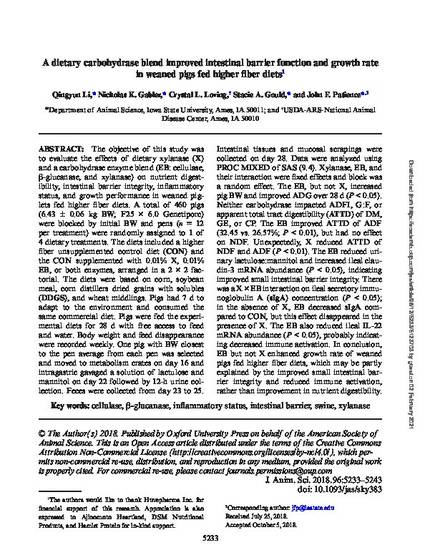
The objective of this study was to evaluate the effects of dietary xylanase (X) and a carbohydrase enzyme blend (EB: cellulase, β-glucanase, and xylanase) on nutrient digestibility, intestinal barrier integrity, inflammatory status, and growth performance in weaned piglets fed higher fiber diets. A total of 460 pigs (6.43 ± 0.06 kg BW; F25 × 6.0 Genetiporc) were blocked by initial BW and pens (n = 12 per treatment) were randomly assigned to 1 of 4 dietary treatments. The diets included a higher fiber unsupplemented control diet (CON) and the CON supplemented with 0.01% X, 0.01% EB, or both enzymes, arranged in a 2 × 2 factorial. The diets were based on corn, soybean meal, corn distillers dried grains with solubles (DDGS), and wheat middlings. Pigs had 7 d to adapt to the environment and consumed the same commercial diet. Pigs were fed the experimental diets for 28 d with free access to feed and water. Body weight and feed disappearance were recorded weekly. One pig with BW closest to the pen average from each pen was selected and moved to metabolism crates on day 16 and intragastric gavaged a solution of lactulose and mannitol on day 22 followed by 12-h urine collection. Feces were collected from day 23 to 25. Intestinal tissues and mucosal scrapings were collected on day 28. Data were analyzed using PROC MIXED of SAS (9.4). Xylanase, EB, and their interaction were fixed effects and block was a random effect. The EB, but not X, increased pig BW and improved ADG over 28 d (P < 0.05). Neither carbohydrase impacted ADFI, G:F, or apparent total tract digestibility (ATTD) of DM, GE, or CP. The EB improved ATTD of ADF (32.45 vs. 26.57%; P < 0.01), but had no effect on NDF. Unexpectedly, X reduced ATTD of NDF and ADF (P < 0.01). The EB reduced urinary lactulose:mannitol and increased ileal claudin-3 mRNA abundance (P < 0.05), indicating improved small intestinal barrier integrity. There was a X × EB interaction on ileal secretory immunoglobulin A (sIgA) concentration (P < 0.05); in the absence of X, EB decreased sIgA compared to CON, but this effect disappeared in the presence of X. The EB also reduced ileal IL-22 mRNA abundance (P < 0.05), probably indicating decreased immune activation. In conclusion, EB but not X enhanced growth rate of weaned pigs fed higher fiber diets, which may be partly explained by the improved small intestinal barrier integrity and reduced immune activation, rather than improvement in nutrient digestibility.
Available at: http://works.bepress.com/john-patience/97/

This article is published as Li, Qingyun, Nicholas K. Gabler, Crystal L. Loving, Stacie A. Gould, and John F. Patience. "A dietary carbohydrase blend improved intestinal barrier function and growth rate in weaned pigs fed higher fiber diets." Journal of animal science 96, no. 12 (2018): 5233-5243. doi:10.1093/jas/sky383.